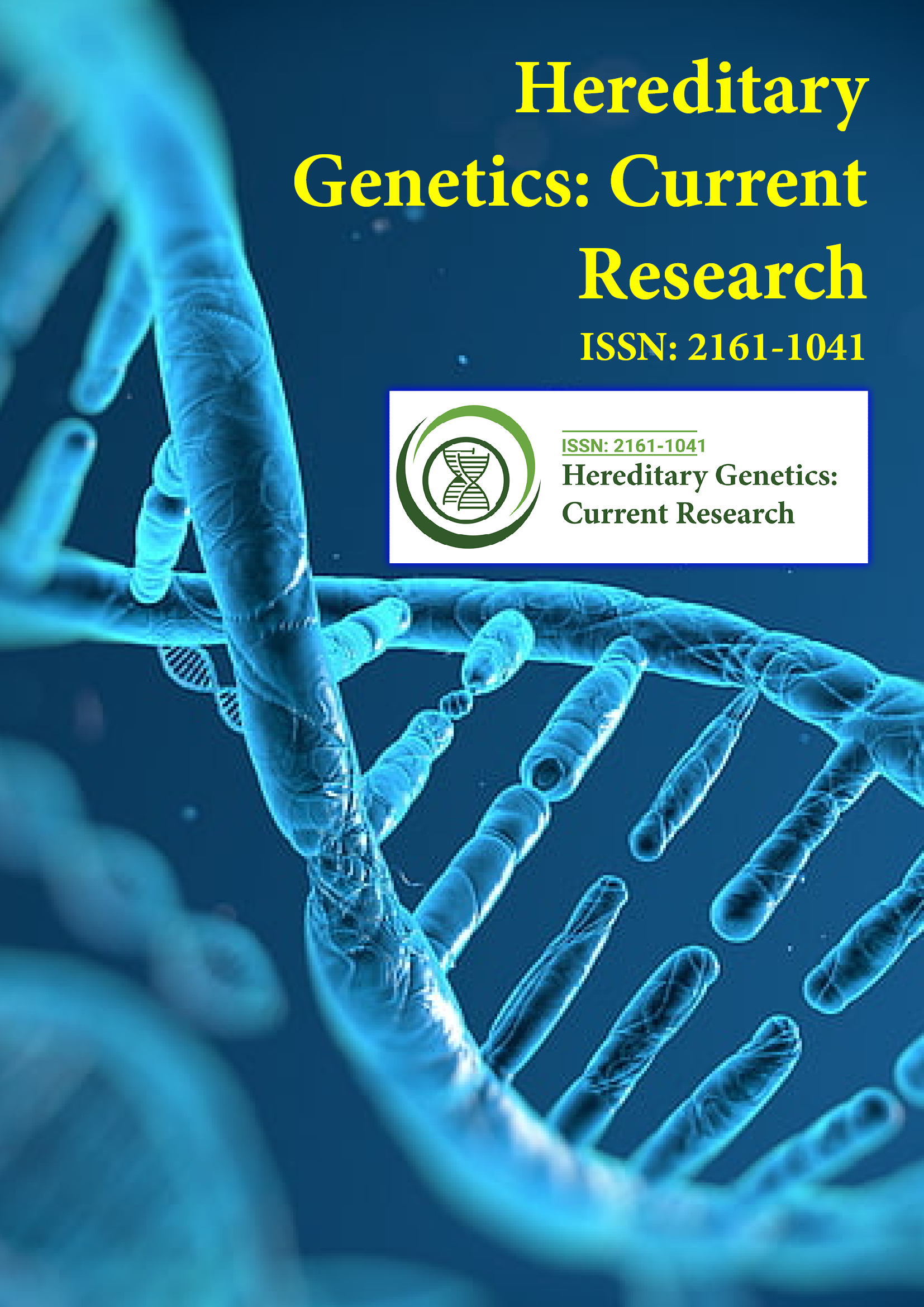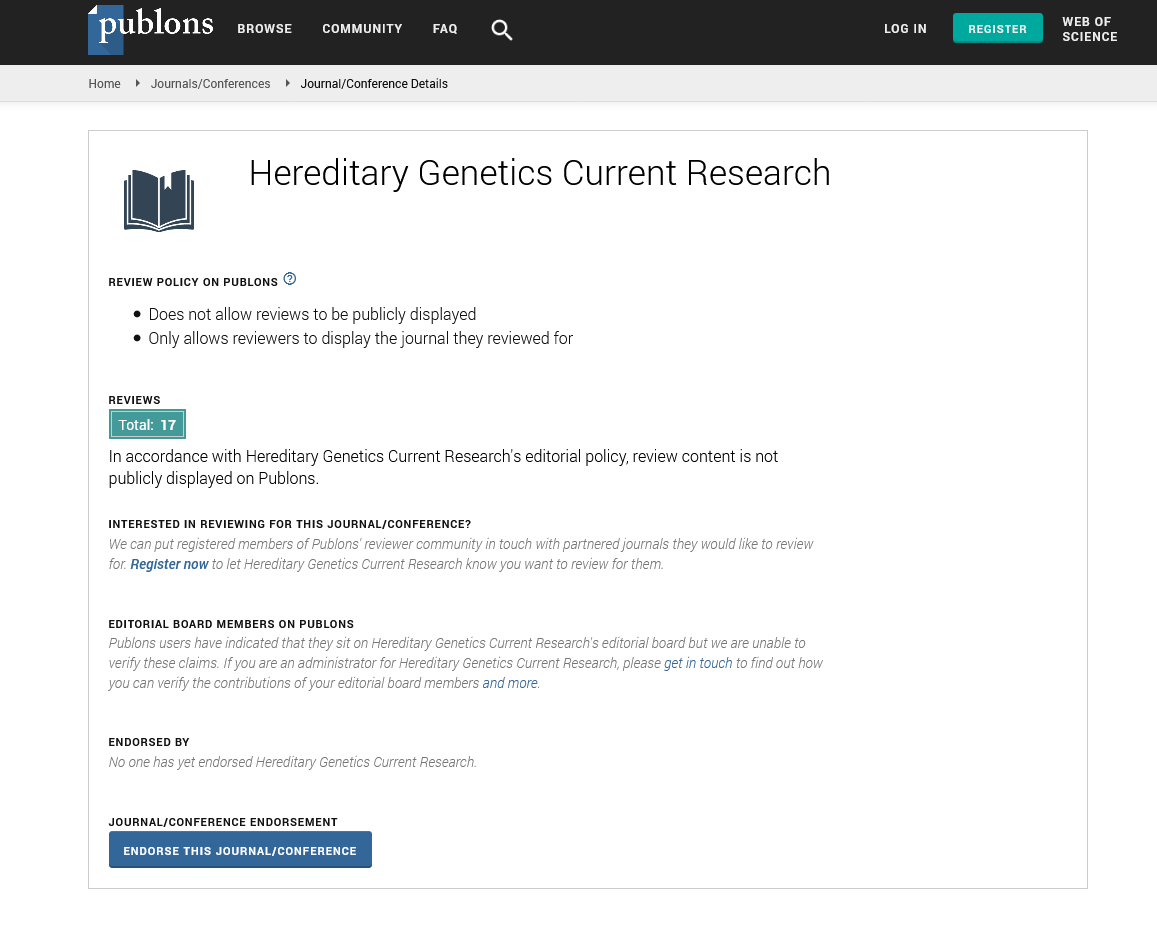Indexed In
- Open J Gate
- Genamics JournalSeek
- CiteFactor
- RefSeek
- Hamdard University
- EBSCO A-Z
- NSD - Norwegian Centre for Research Data
- OCLC- WorldCat
- Publons
- Geneva Foundation for Medical Education and Research
- Euro Pub
- Google Scholar
Useful Links
Share This Page
Journal Flyer

Open Access Journals
- Agri and Aquaculture
- Biochemistry
- Bioinformatics & Systems Biology
- Business & Management
- Chemistry
- Clinical Sciences
- Engineering
- Food & Nutrition
- General Science
- Genetics & Molecular Biology
- Immunology & Microbiology
- Medical Sciences
- Neuroscience & Psychology
- Nursing & Health Care
- Pharmaceutical Sciences
Commentary - (2022) Volume 11, Issue 3
Transmission of Genetic Blood Disorders and its Impact on Inherited Genes
Rickes Warlow*Received: 02-May-2022, Manuscript No. HGCR-22-17212; Editor assigned: 06-May-2022, Pre QC No. HGCR-22-17212 (PQ); Reviewed: 19-May-2022, QC No. HGCR-22-17212; Revised: 26-May-2022, Manuscript No. HGCR-22-17212 (R); Published: 09-Jun-2022, DOI: 10.35248/2161-1041.22.11.216
Description
Hereditary blood abnormalities parents might pass genetic blood disorders to their offspring. Red blood cell synthesis is decreased, which leads to several blood diseases. When the generation of these red blood cells stops, it leads to blood abnormalities in people's bodies and may cause significant diseases since red blood cells in our bodies do not stay forever and must be generated after a period of time. Sickle cell anemia and thalassemia are two related abnormal haemoglobin disorders.
Genes on chromosomes can pass such disorders from parents to offspring. There is a 25% probability that a kid will have sickle cell illness if both parents have the sickle cell trait. However, the likelihood that their child would inherit the disease increases to 50% when one parent has the characteristic and the other really has the condition.
Signs and symptoms of blood disorders
The severity of the condition affects how severe the Hidradenitis Suppurativa symptoms are. Many patients with HS have minor anemia or no anaemia at all because the body spontaneously creates additional red blood cells in the bone marrow to make up for a low haemoglobin level. The new cells tend to be immature since the bone marrow is under more pressure to produce more of them. Reticulocytes are young, immature red blood cells that are only abundant when the body needs to create more red blood cells.
The reticulocyte count can be used to gauge this process. More red blood cell oxidation than typical can occur under certain circumstances, including infection, fever, and physical stress. If this happens, the body will attempt to increase the amount of red blood cells produced in order to keep up with the rate of cell death. The reticulocyte count can be used to gauge the body's capacity to compensate for losses. The haemoglobin level will remain constant (or only slightly decrease) and the reticulocyte count will rise if the body is able to manufacture enough red blood cells to keep up with the rate of red blood cell destruction occurring in the spleen. The body cannot keep up with the increasing demand if the reticulocyte count is low.
The increased requirements for red blood cell synthesis are too much for the body to handle. As a result, the anaemia worsens, and the spleen frequently enlarges in such circumstances.
Hereditary blood diseases and their types
White blood cell disorders, red blood cell disorders like anaemia, and bleeding (platelet) disorders are all examples of benign blood conditions. Like sickle cell anaemia, leukaemia, and lymphoma, other blood abnormalities can be fatal or lead to chronic sickness.
Abnormalities of the bleeding (platelet): Platelets help to stop bleeding by forming clots. Disorders of the bleeding (platelets) are rare. If you have a bleeding problem, you can bleed excessively during an injury or following surgery. Medical illnesses or drugs may contribute to bleeding disorders or they may be acquired. Some are genetically determined. Sometimes bleeding problems have no known cause.
Red blood cells disorders: Oxygen is carried by red blood cells all over the body. If one of these blood cells components is malfunctioning, you could have a red blood cell problem.
Diagnosis
Hereditary nonspherocytic hemolytic anaemia can be diagnosed solely based on the results of a person's bloodwork. What type of anaemia someone has can be determined by looking at the membrane, or outer layer, of a pink blood mobileular under a microscope. The particular kind of anaemia can also be determined via genetic testing. A multigene panel, or one test that could look for changes in several genes, is how genetic testing is frequently carried out. Genetic counselling may be helpful to better understand genetic testing options, how the condition is inherited, and how it affects immediate family members. There are few therapeutic options for inherited blood diseases. Although their response may only be partial or temporary, animals with primary immunodeficiencies may also benefit from antibiotics. Additionally, plasma transfusions may help bleeders with coagulopathies. Both gene therapy and experimental allogeneic bone marrow transplantation have been tried to correct defective blood cells. However, it's far more important to control how the disorder causing gene spreads by utilising breeding animals that have been screened while tests are still accessible. Although external causes of anaemia, including as infections, immune system problems, intoxication, blood loss, and persistent organ failure, are the main causes, genetic blood problems that cause anaemia are equally crucial in scientific practise.
Citation: Warlow R (2022) Transmission of Genetic Blood Disorders and its Impact on Inherited Genes. J Hereditary Genet. 11: 216.
Copyright: © 2022 Warlow. R.This is an open-access article distributed under the terms of the Creative Commons Attribution License, which permits unrestricted use, distribution, and reproduction in any medium, provided the original author and source are credited.

